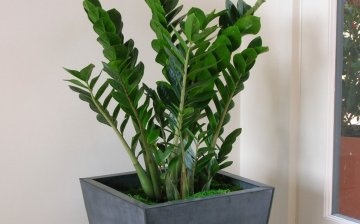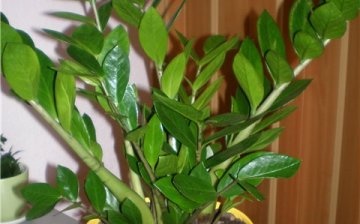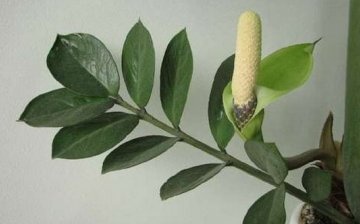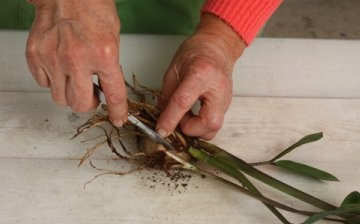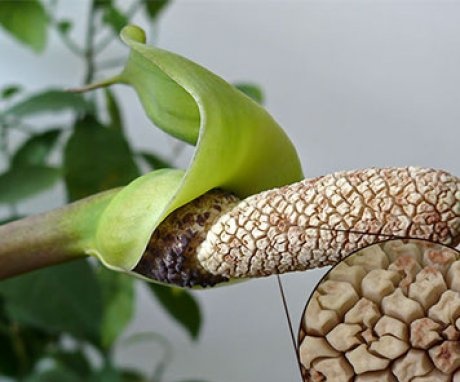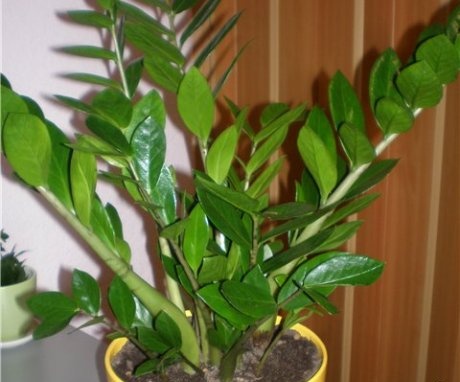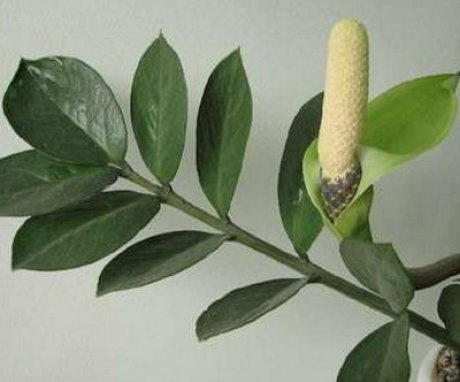Zamioculcas flower: structure, care and reproduction
African plant from the aroid family - zamioculcas is one of the most popular indoor plants to date. The fair sex was captivated by its magnificent leaves and rather easy care. Zamioculcas belongs to the group of succulents characterized by the ability to store moisture in the area of fleshy stems, roots and leaves. These reserves help the plant survive the onset of dry conditions.
Content:
- Features of the structure of the flower
- How to care for a flower?
- Diseases and pests of zamiokulkas
- We propagate zamiokulka
Features of the structure of the flower
Brought to us from the vastness of Africa, zamiokulkas immediately became a rather popular and demanded houseplant among housewives. The reason for this was the rather rich green leaves with a bloom of wax and a huge tuber lying underground.
Features of the plant:
- The leaf shape of this plant is rather large, representing not large leaf blades sitting on the surface of the fleshy petioles.
- The feathery leaves of zamiokulkas store in themselves a significant amount of liquid to withstand unfavorable arid conditions.
- Zamioculcas blooms very rarely, especially when grown at home.
- In appearance, the corolla of a flower is similar in shape to an ear, which is a collection of small and inconspicuous flowers.
- The cob is formed at the bottom of the plant, where it is almost invisible, as it is covered with green leaves.
Zamiokulkas growth is rather slow. The mature zamiokulkas plant grows to a height of about one meter, which is why it is so well suited for growing in residential areas. The main purpose of growing this plant is decorative decoration the interior of the rooms, as its rich green color fits perfectly into it.
How to care for a flower?
When growing this plant at home it is necessary to create conditions similar to the climate of the African desert, since it was brought to us from those places. In other words, zamioculcas grows well in dry and warm conditions. Caring for this plant is quite simple, which makes it a favorite among many housewives.
A few tips for flower care:
- Good lighting is necessary for the growth of zamiokulkas, but a slight shade of the room will not greatly affect its growth.
- Moderate watering it is not important for him, he loves more dry soils, close to deserts.
- Optimal temperatures for its growth are from fifteen to thirty with a plus sign. A decrease in the temperature background of the environment is unfavorable for the growth of zamiokulkas, especially if the plant is waterlogged.
- In the winter season, this plant is watered no more than twice a month, and in the summer months the plant is watered as the soil layer dries out.
- Zamioculcas is not at all picky about the level of fertility of the land on which it grows. However, clay soil should not be placed in containers for its cultivation, as it does not allow moisture and air to pass through, which will depress the growth of the plant.
- For zamioculcas, it is important to have a good drainage layer, due to which excess moisture will be removed.
At home, zamioculcas is best placed for growing on windowsills on the south side. It is here that he will receive the maximum light and moisture necessary for his growth. If the windows of your house face the north side, then the plant will be able to grow there, only a little slower. Watering in this case should be done as rarely as possible, and due to a lack of light, the plant may not form large leaves. With the onset of summer, the zamiokulkas plant can be placed on the balcony.
Often transplanting this plant is not recommended, since it already has very slow growth.
If the roots of the zamiokulkas fill the entire space of the container it occupies, transplanting into a larger dish is simply necessary. When planting zamiokulkas plants in another dish, you should not deeply deepen the tubers into the soil. This can negatively affect the growth of the plant. It is desirable that the tubers are slightly visible on the surface layer of the soil.
Produce top dressing This plant follows a specially produced fertilizer, which is used for feeding succulents or cacti. It is necessary to carry out this event during the active growth of the plant, no more than once a month. In winter, it is not advisable to make top dressing, since the zamiokulkas is at a dormant stage.
Diseases and pests of zamiokulkas
Unlike other indoor plants, zamioculcas is rarely affected diseases and pests... The destructive effect on the plant is not moderate and abundant. watering... This becomes the cause of decay of individual roots and the entire root system.
If you notice rotten roots in a plant, then you need to remove it from the capacity it occupies and remove the roots affected by rot.
Sprinkle the rest of the root system with a little crushed charcoal and then dry it a little. After that, the plant should be transplanted into a container with a new soil filling, and then follow its watering.
If yellow leaves are found in a plant, this is a consequence of damage to the plant by any diseases... With the appearance of new green leaves on the plant, the old and yellowed ones sometimes die off. Often, against this background, dark spots appear on the surface of the stem. Yellow leaves should be removed as they spoil the appearance of the plant.
The main enemies in terms of sabotage in zamiokulkas are:
- Aphid
- Shield
- Spider mite
To combat these insects, you can purchase specialized drugs and use them to process the plant.
We propagate zamioculcas
Zamioculcas reproduces seeds and vegetatively. At home, it is better and faster to propagate this plant vegetatively. Most often, a new plant is obtained by separating it from the mother plant in the area of the rhizome. The daughter plant is slightly dried and planted in a previously prepared container.
Another method of reproduction is vegetative division of a complex leaf:
- At the same time, a part of such a leaf with a bud is separated and also dried a little.
- The dried part of the leaf is then placed in a prepared pot with earth.
- Then watered a little and placed on the windowsill.
There is another way of reproduction of zamiokulkas, which is carried out using a leaf blade.
- A leaf blade is separated from the plant and dried a little for two days.
- Then this plate is placed in a previously prepared container with sandy soil and watered.
- Deepening the sheet into the sand should be done by one third of the sheet.
- Then the planted sheet is covered with a jar, periodically airing.
Reproduction in this way is the longest, since the root-forming process is rather slow.Propagate zamioculcas seeds in the temperate zone of our country it is quite difficult, since not all stores have its seeds on sale.
More information about transplanting a flower can be found in the video.



